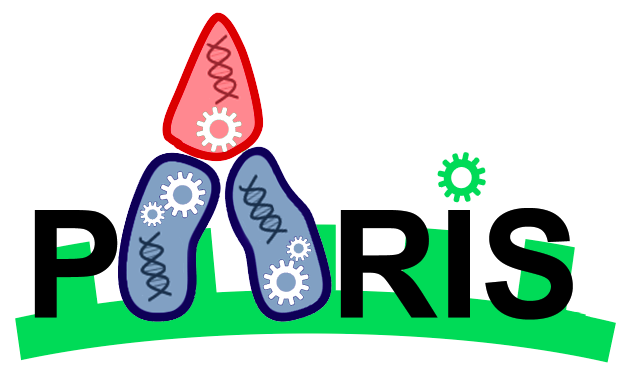Paris/Project Description
From 2007.igem.org
Under construction
Our project will have 3 main parts:
- Construction of a synthetic multicellular organism
- Construction of a security device, enabling the secured isolation of the soma
- Optimization of triglycerides synthesis in the soma of the synthetic organism
A synthetic multicellular organism
The idea is to make a multicellular organism out of bacteria. This simple organism will have two distinct types of cells. The first one would be the germline, the other one the soma. The germline will be auxotroph for a given nutriment, which will be provided by the soma. The soma will differentiate from the germline and will be unable to divide. In this way, there is a need for a part of the germline to differentiate into soma in order to feed the rest of the germline. Hence, the soma doesn't exist without a germline to generate it. more...
A security device
We also came up with the idea of modifying the synthetic organism so that we would be able to induce the differentiation of all the germline into soma in a secured way. Why would we want to do that ? Well, in a security perspective, we may not want to release a transgenic strain in the environment. But it would be acceptable to do so if we are sure that the cells we release are not able to proliferate. In this view, we could release in the environment, what would correspond to our "soma". Those cells aren't able to divide and their effect is limited in time since they will die after approximatively 2h. Indeed, one of the problems with GMO is the selective advantage that the gene gives. If it is greater than for the wild type, the GMO will spread and replace the wild type in the ecosystem. For example, if we think about the gut flora, a genetic engineered E.coli could spread and replace the wild type E.coli causing diseases (diarrhoea...). That could be possible because the reproductive faculty is linked to the gene given: the gene gives a better reproductive capacity of the GMO. One way to avoid this problem is decoupling the reproduction faculty and the expression of the gene: the organism is either able to multiply or able to express the gene. So expressing the transgene can not be responsible of a selective advantage against the wild type.
Optimization of triglycerides synthesis in the soma of the synthetic organism: towards a new slim diet
A bacterial multicellular organism could allow optimizing the production of compounds deleterious to the cell. If you try to optimize the production of such a compound in a classic bacteria (E.coli for instance), you will reach a trade off between the production of your compound and the growth of the cell because the reproduction capacity is linked to the expression of the toxic transgene. The synthetic organism could in part bypass this problem, decoupling both basis functions. It could indeed be modified so that the soma only will produce the noxious molecule and the germline will multiply. If there is a way to screen for the production of this molecule, we can then select the germline whose soma would have the best yield. As long as the production doesn't impair to much the capacity of the soma to feed the germline, the optimization can go on. Thus, their is also a trade off in this case, but it might very well be more favorable to the optimization than the trade off between production and growth. At least, this is worth testing.
Of course, all this is only possible if the germline is not affected by the production of the soma. Compounds that could be optimized in this way are thus constrained to molecules that can be noxious in the cell, but that do not affect it to much if in the medium.
Finally, the last part of our project would be to bring together the synthetic organism, the optimization of a compound noxious to the bacteria, and the security device. To do so, we'd like to optimize the production of triglycerides in the soma cells of our synthetic organism. We would then be able to differentiate all the germline of the synthetic organism into soma in a secured way. Those super triglycerides-producing-not-able-to-divide cells could then be ingested. The fatty acids they would stock would be as many fatty acids you will not absorb! Eat fat, don't get fat !
Triglycerides are made of a molecule of glycerol esterified by three fatty acids. When ingested they are hydrolysed by lipase in the stomach and the duodenum, into glycerol and free fatty acids. Enterocytes are only able to absorb free fatty acids and glycerol. So they combined them in the cytoplasm into triglycerides that will be free in the lymphatic system then in the blood within fatty vesicles called chylomicrons.
When we are becoming fat, it is because we have more input than output energy, lipid energy. Knowing that gut is full with bacteria forming the gut microflora (we have 1013 of our cells in our body and 1014 bacteria in the gut!), we could imaging having a somatic cell bacteria able to absorb fatty acids and form triglycerides intracellular inclusion. These triglycerides are not able to be absorbed by enterocytes! Input lipid is decreased! Eat fat, don't get fat!
E.coli is the most used bacterium in synthetic biology and... belongs to the gut microflora! We could also imagine
genetically engineering E.coli to stock triglycerides into inclusions! Knowing that 40% of E.coli are renewed every day, these triglyceride-fulled bacteria will leave the gut with feces!
With the security device described above we should have a safe GMO with two hours life expectancy!
